Processing: Analogue / Digital Material Surfaces (imprecise with precise tools): A collaborative student-staff workshop with international guests
Dan Robinson, Leeds College of Art
Dan Robinson has been an artist and educator for about 15 years but never expected to feel so delighted by learning to draw a dot, albeit on sheet metal. This article describes a workshop and exhibition with guest designers Prof. Steffi Hußlein (Magdeburg) and Rob Laux (Berlin) held on 14 – 16 November 2011 at Leeds College of Art (LCA). The workshop explored digital and analogue methods of gen...
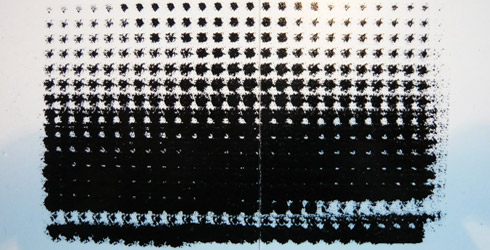
Keywords: student-staff collaboration, internationalism, ‘Processing’ and generative design, digital versus analogue, GIDE (Group for International Design Education), interdisciplinarity
Abstract
I’ve been an artist and educator for about 15 years but never expected to feel so delighted by learning to draw a dot, albeit on sheet metal. This article describes aworkshop and exhibition with guest designers Professor Steffi Hußlein (Magdeburg) and Rob Laux (Berlin) held on 14 – 16 November 2011 at Leeds College of Art (LCA). The workshop explored digital and analogue methods of generating images and manipulating materials for art and design. Participants learned to create code using ‘Processing’ (open source generative design software) to drive machinery such as computer numerical control (CNC)1 routers and laser machines. Staff-student collaboration and practical experimentation were encouraged. Highlights included the glee that filled the room when a computer began drawing with sand and an unexpected dance by a video camera strapped to a machine toolhead. Outcomes were displayed in a publication and exhibition in the BA (Hons.) Art & Design Interdisciplinary studios as part of Leeds Digital Festival. As organiser, I had the opportunity to invite guests from Germany through LCA’s membership of Group for International Design Education (GIDE).
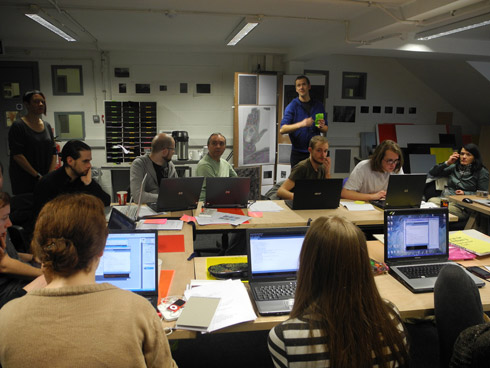
Figure 1
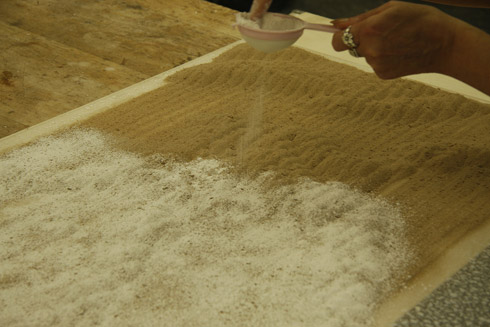
Figure 2
Background and context
The aim of the ‘Processing’ workshop was to create a dynamic collaborative learning event where students, lecturers, tutor-technicians and international guests could experiment and share knowledge. We wanted to develop participants’ understanding of experimentation, collaboration and new technology as vehicles for innovation in art and design. The idea was to facilitate greater understanding of the potential of working together across different disciplines through digital and analogue, 3D machine technologies and generative design with a range of materials. We wanted to question the qualities of analogue and digital techniques by marrying the precision of computer-control with the imprecision of hands-on making, mess and mistakes. By inviting participants with a range of expertise and institutional roles the workshop aimed to be inclusive and self-sufficient, with all participants supporting each other’s learning.
The initial idea for the event came from an experience I had co-teaching a workshop in Magdeburg Stendhal, Germany with Professor Steffi Hußlein and designer Rob Laux, as part of the Group for International Design Education (GIDE). GIDE is a network of seven European design institutions (Milan, Mechelen, Dundee, Leeds, Ljubljana, Lugano and Magdeburg) who, since 2003, rotate annual hosting of face-to-face meetings and collaborative student workshops. Research-led themes are explored through presentations, site visits and 3D construction. The theme continues for a year underpinning final year student briefs in all seven countries. Magdeburg’s workshop title was ‘Creativity for local enterprise’. The 2011-12 theme, ‘Design in Action’, was set by Duncan of Jordanstone College of Art and Design (DJCAD), University of Dundee, linked to their participation in the AHRC Knowledge Exchange Hub 'Design in Action’ with V&A at Dundee.
At GIDE Magdeburg 2011, over three frenetic days in a vast hall with 200 hundred international students, our small ‘Physical Computing’ group used ‘Processing’ and simple Arduino circuits to create an interactive installation. Our group felt something like Heath Robinson at NASA, as we grappled to attach computers to a tangle of wires, switches, blue-tac and an array of random objects (hammer, bottle, teabags). The outcome was a tabletop set up, where objects were handled to trigger sounds and animations projected from above. It was an exciting place to meet Steffi and Rob. Their passion about ‘opening up’ computers (literally and metaphorically) and sharing their knowledge of how to do this was inspiring. Rob showed me images of his personal experiments (mis)using portable CNC routers to scratch, grind and draw into the surface of sheet metal and acrylic off-cuts. His imagery combined portraits, technical drawings and complex abstract linear waveforms. I was struck by the potential impact of these processes for work at LCA. I also saw a connection between Rob’s use of code and machines to draw on the surface of materials, and with my colleague Cheryl Huntbach’s drawing with simple hand tools to prick paper. Erasmus funds are available for staff exchanges so we started discussing workshop ideas for Leeds, at first during a student visit to Berlin and following up via email and Skype.

Figure 3
The 16 workshop participants were eight final year students and four tutors from the BA (Hons.) Art & Design Interdisciplinary programme, and four tutor-technicians from the 3D workshop and digital resource areas. The students responded to an open ‘call for participants’. The workshop was facilitated by Steffi Hußlein, Rob Laux, Cheryl Huntbach and me and was funded by the programme area, staff development and Erasmus Staff Mobility funds.
When setting up the workshop as a collaboration between different individuals and institutions I was helped by my previous experiences as an artist, teacher and doctoral student. I’ve worked with site-specificity, interdisciplinarity, dialogue and the art institution (Esche, 2009; Rogoff, 2007; Kwon, 2004). A previous collaborative project, ‘Interview – between the art academy and society’ for Situation Leeds (Robinson, 2005), gave me a lot of confidence because we had such a positive impact helping facilitate working relationships that were sustained after the event.
The BA (Hons.) Art & Design Interdisciplinary programme at LCA aims to develop students as flexible practitioners able to respond creatively within a range of situations. Our studio-based course has a strong emphasis on collaborative projects and use of the excellent workshop resources at Leeds. This allows the development of hands-on making skills, object-making and materials innovation.
The 3-day workshop took place 8 weeks into the final year of the degree, in the ‘Professional Practice’ module which enables students to research, develop and present their individual practice direction. We wanted to be a catalyst for studio and workshop activity with the theme ‘Creativity for local enterprise’.
Prior student learning relevant to the ‘Processing’ workshop includes a level four brief, ‘Digital surfaces’. During this brief students are taught ‘Photoshop’ and ‘Illustrator’ software in conjunction with 3D material processes such as photo-etching, routing or transfer printing on metals, plastics, wood and ceramics.
The result was a staff-student, international, practice-research, hands on, interdisciplinary, material-surface, precise and imprecise workshop during which we learned to write computer code from scratch using ‘Processing’ in order to create drawings with a range of material surfaces. Cheryl Huntbach said, “It was an intense, challenging and rewarding three days.” (Huntbach, 2011)
The workshop and exhibition
Processing is an open source programming environment for people who want to create images, animations, and interactions. With the coding based system data in many formats can be imported, manipulated, and exported. The potential of the software environment of Processing combined with the CNC or photo-etched process of "tooling" (milling, drilling, shaping and sketching) opens new challenges for designers. The Processing based sketches becomes tactile with material properties (Hußlein, 2011).
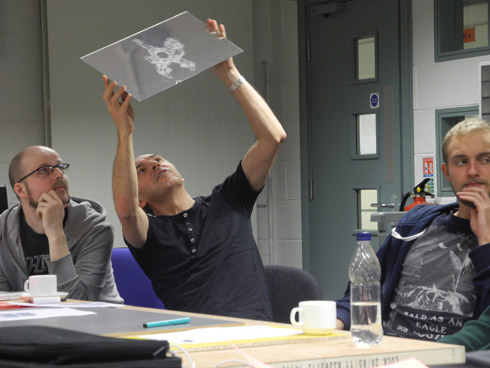
Figure 4
Before the workshop participants shared research and imagery with a project blog. This meant ideas were already bubbling before we met. Day one began with introductions and presentations of recent interaction design, imagery generated with Processing, early computer art (Darrel Viner) and a range of drawing practices (DJ Simpson, Sol Lewit, Sian Bowen, Tara Donovan, Anne Wilson). After lunch we got down to learning Processing and G-code, the programming language to control a CNC router. A router is a tool used to engrave lines or hollow out areas in the face of sheet materials, and is commonly used in CNC machines. When tasks required small group work, we made sure the groups included academic staff, technical staff and students.
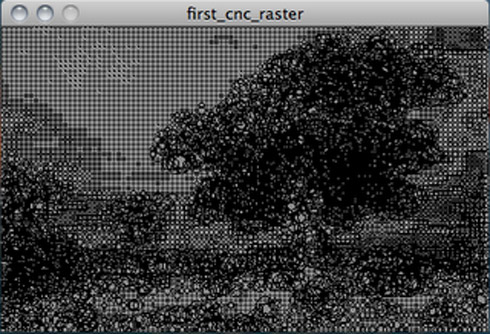
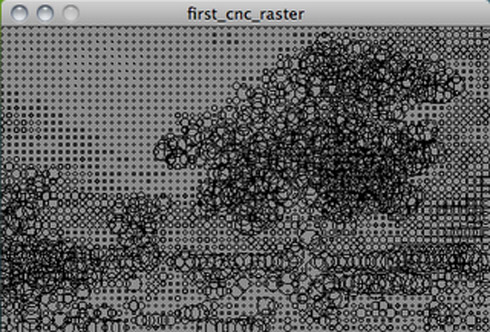
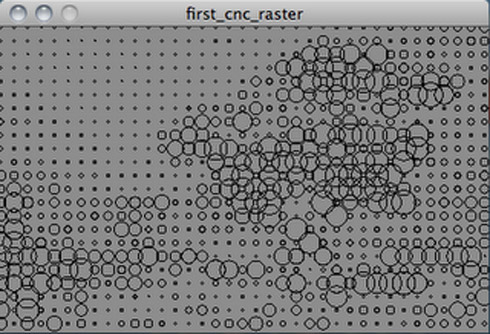
Figures 5 a - c
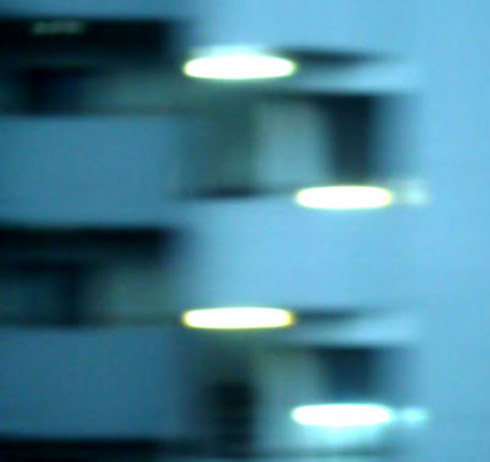

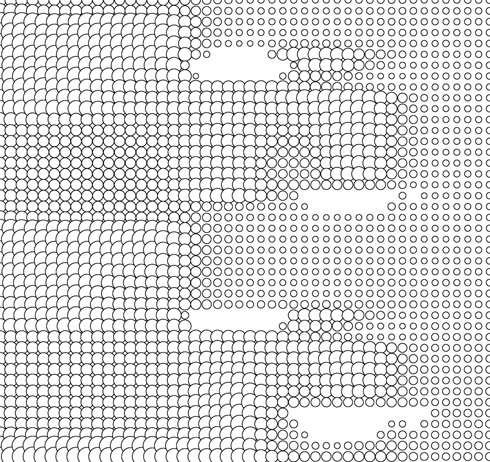
Figures 6 a - c
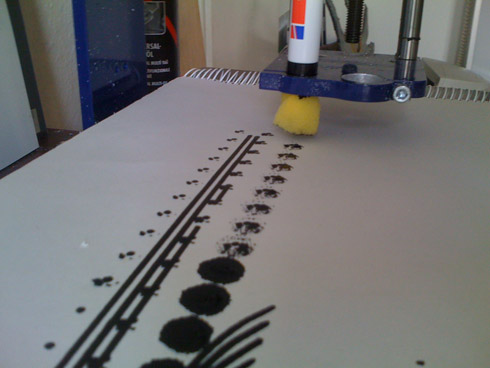

Figures 7 a - b
Day two involved learning more code and experimenting with increasingly complex shapes and commands. At various moments a great sense of achievement was felt by individuals who managed to make a dot, draw a line or create a circle. For most of us, the use of a new coding language to make a machine draw was entirely new and the sense of achievement was palpable. It was also inspiring to witness students who perceived themselves as ‘non-technical’ assisting staff to understand computer code.
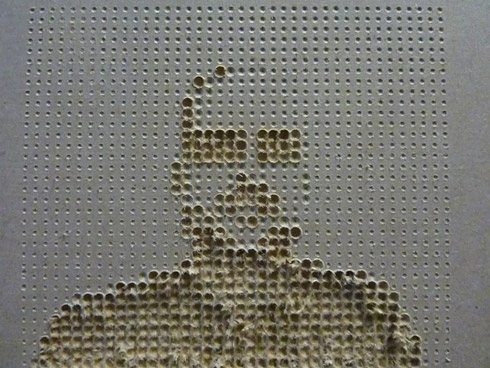
Figure 8

Figure 9
Why should artists use CNC machinery, code and programming? Coding is new to virtually all the participants who have no experience in developing complex scripts to feed the computer. So in programming terms the results are very basic and the challenge is to develop an artistic standpoint. Manual control of a tool is much more direct. So for everybody it felt like drawing a picture without using their hands, guiding the brush only by giving spoken commands. After getting over this frustration the workshop showed what could be achieved even with limited abilities (Laux, 2011).
The intense concentration required also led to some unpredicted responses. Contextual studies lecturer Joanna Geldard reconfigured snippets of Processing code into a poem. This is an extract:
When traversing at a rapid notion of F600 leaves a rendered circle ellipse
In the left brained clockwise motion
M02 end programme
A smooth ramp 0.3mm
See my ramp at 0.1mm
At an inch, my data is out of joint
This sidestep, coupled with an earlier proposition by student Patrick Kirk-Smith to design a code to reconfigure the lyrics to Barry Manilow’s ‘I Write The Songs’ set a new course, for a small group of us, who decided on day three to focus on manipulating text. Experiment and play were encouraged and generated great results.
Day three began with establishing four groups, each made up of students, academic and technical staff. Groups were formed around different interests of individuals in response to the workshop so far, with the following working titles:
- The process of image making
- Text, code, language & boundaries
- Interference & light
- Abstraction, pattern & interruption


Figures 10 a - b
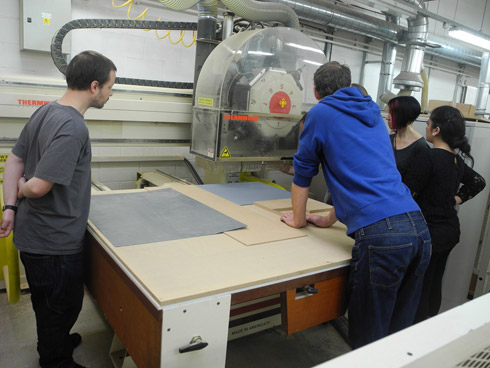
Figure 11
Now participants could focus on putting their new coding knowledge into practice. Day three was very experimental and fast-paced. Student Adam Cluley attached his video camera to the CNC tool-head. The outcome was an unexpected three minute video capturing a kind of dance – we see a tool-eye-view of the machine, milling and spitting sawdust as it skates and pirouettes across the surface of a piece of shuttering plywood.
…a Kinect videogame input device might be directly connected to a numerically controlled drill. Why would anyone ‘mash’ a videogame controller onto an industrial construction tool? Because it’s cheap and easy to do – that’s why. Because that feat attracts admiration. Because this ungainly hybrid might become a ‘platform’ for creating something else… (Sterling, 2011, p.68)
The two days following the workshop were also significant. The students involved worked with tutors to curate and install outcomes from the workshop within our exhibition space. We used pages of our publication to tell the workshop narrative as a wall display. The blog was printed on a 15-metre long piece of paper and hung through a gap in the ceiling tiles, appearing to fall and flow across the floor.
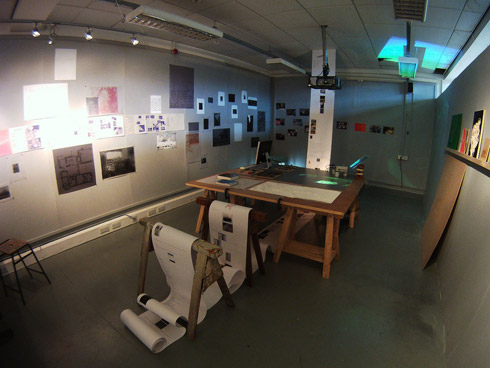
Figure 12

Figure 13
Our workshop table was reconstructed as a plinth to display tools, material tests, animations and two particularly inventive CNC experiments: a drawing relief made by Roger Berry strapping an improvised sand dispenser to the CNC machine head and a table-top video projection retracing the path danced by the CNC machine.
Imprecise with precise tools
This theme was integral to the workshop ethos. The subtitle, ‘imprecise with precise tools’, was suggested by Steffi and Rob. It hints at a useful tension between digital and analogue, machine and human, computer-controlled plot versus the hand-made mark. There is a wider implication that chance, mistakes, mess and hands-on making are essential in the post-digital age. In the weeks before the workshop in a seminar on that year’s GIDE theme ‘creativity for local enterprise’ we considered Thomas Heatherwick’s Extrusions (2009). Heatherwick’s seats are made from a single misshapen piece of extruded aluminium and seem to rely on the possibility of accident, failure and a necessary level of trust between mechanised industry and the creative practitioner. Digital-analogue debates were also played out in the recent show, Power of Making at the V&A, guest-curated by Daniel Charny and subtitled, ‘the importance of being skilled’. In his essay for the accompanying publication, Professor Sir Christopher Frayling writes ‘some educationalists have argued about schoolwork that the 3Rs should really be ‘reading, wroughting, rithmatic’ (Frayling, 2011). Perhaps our workshop suggests wroughting may better be replaced with routing.
Evaluation
As an approach to teaching and learning, I believe our workshop shows that student-staff collaboration in learning new skills and producing and exhibiting work can enable more complex learning to take place, than the sometimes more hierarchical tutorial, lecture and crit scenarios. Benefits included a more meaningful possibility of research-led teaching and teaching through example. Students witness the tutor-practitioner solving problems, making mistakes. Student Elisa Heikkila described working alongside tutors as ‘an important experience, being able to work alongside and witness the decision making processes of professional artists and designers.’ (Heikkila, 2011). This is not to propose ‘non-hierarchical’ as a straightforward concept. Far from it, lack of structure and formality may reinforce latent hierarchies; individuals may dominate or coerce each other through ‘collaboration’. I use the term non-hierarchical with caution as a means to investigate collaborative approaches to student-staff learning.
Reflecting on the workshop a week later, student Adam Cluley commented, ‘They [Steffi and Rob] were excited about how this new technology meant we could work without technicians, instructors, and machine operators, but I kept thinking, does that mean they’re all out of a job?’ Writing later in our course journal, Inter Xy – the quarterly journal, edited and produced by students on the BA (Hons.) Art & Design Interdisciplinary programme at Leeds College of Art, which emerged from practice-writing workshops delivered jointly by critical studies and studio staff –Adam references Charlie Chaplin’s film ‘Modern Times’ as a critique of technology-worship, ‘The monotonous and relentless task of tightening bolts, and an undignified encounter with a feeding machine, leads to Chaplin going rogue and upsetting the careful balance of the factory’ (Cluley, 2011).
The week prior to the workshop I had attended a one-day drawing symposium hosted by the LCA Foundation Diploma in Art & Design. In his presentation, Professor Juan Cruz (Liverpool John Moores University) discussed teaching art ‘in-the-present’. His talk proposed that most art teaching is either about work that was made earlier, as in a crit scenario, or work that is yet-to-be-made, the proposed idea. He reflected on rare moments when teaching occurs during the actual process of making art and presented the life-drawing class as an example of this. He described the usefulness of the final drawing being disposable and the focus being on the process of drawing itself. ‘The tutor can discuss the work while it is being made, they may physically intervene with a mark here, something rubbed out there.’ (Cruz, 2011)
Cruz’s idea returned to me during our workshop. In our shifting roles as learners and teachers we were all making work and discussing it in the present. Each of us took in information, responded and made decisions alongside each other. Although our workshop may seem very distant from the life-room we were co-producing drawing and learning, in the present tense.
Most participants were less concerned with the whole agenda (internationalism, collaboration, digital-analogue, generative design, drawing, precise-imprecise qualities, interdisciplinarity) but focused on individual interests and directions. All participants struggled at different points. It was therefore important to manage expectations, for example by reiterating the experimental nature of the workshop, the possibility that individual work could continue beyond the workshop and the shared student-staff dynamic. As students and tutors, the shared task of representing our workshop in a public exhibition within two days gave focus, supported critical decision-making and facilitated learning about curatorial and installation strategies. Lecturer Joanna Geldard commented,
Timing the event at the beginning of year and exhibiting the results within the studio space gave a real boost and has allowed time for responses to unfold over the academic year. It also helped shape peer-group clusters which have enabled students to develop deeper awareness of individual themes and ideas (Geldard, 2011).
The project blog was projected and discussed on a daily basis within the workshop and this helped us to discuss and reflect on work in progress. This helped facilitate the design of a publication produced at LCA using digital and screen printing.
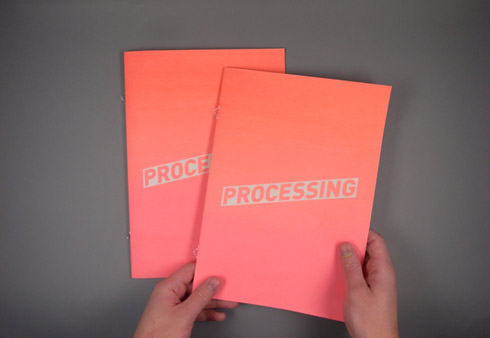

Figures 14 a - b
The blog was also useful when it came to negotiating small interest groups at the start of day three, enabling a participant-led day of experiment to produce such surprising results. The way these groups collaborated around shared themes to produce work has been emulated in our staff practice-research development. Tutor-technician Thomas Knapp said ‘it really inspired me and got me thinking about my own practice again’ (2011).
Co-leading a workshop with staff from a different country and discipline was a fantastic experience. The opportunity to meet, in an atmosphere conducive to indentifying a potential collaboration, was entirely made possible by LCA and Magdeburg’s membership of the Group for International Design Education (GIDE). Steffi and Rob, both from industrial design backgrounds, both commented that they would take the open experimentation and collaborative dynamic back to Magdeburg.
Within the art world today, the discursive formats of the extended library-cum-seminar-cum-workshop-cum-symposium-cum-exhibition have become pre-eminent modes of address and forms of knowledge production (Holert, 2009).
The format ‘workshop’, as learning-event, has rich potential. Multiple agendas unfold in a contained time and space whilst participants can encounter the whole as a singular experience. The reality of an event is complex. Agendas overlap and shift across the multiple viewpoints of participants. Moreover, the nature of ‘participation’ itself (Bishop, 2004; Doherty, 2009) has been widely debated in art education this last decade. On reflection, there was perhaps more scope for our workshop to involve students in the planning stages. There is also further potential to develop collaboration with industry in order to innovate with new technologies. The GIDE group and other external partners at LCA offer good opportunities to develop these areas.
The 16 participants have continued to meet to share individual practice-research and to discuss ideas for developing 3D workshop methods, hardware, software and plans for future events. A subsequent workshop was organised by my colleague Cheryl Huntbach with GIDE guests from Belgium helping students to flock their possessions. (‘Flock’ is small fiber particles, as in flocked wallpaper.) Four months after the ‘Processing’ workshop, students and staff are continuing to experiment with computer-controlled machinery. There has been a series of student-led initiatives including lively discussions, external exhibitions and a course journal devoted to ‘digital-analogue’. These outcomes are together being captured in a year book, jointly edited by students and staff. I learnt a great deal through the experience of this workshop and felt proud when it was used in a recent LCA research strategy discussion as an example of how practice-research, internationalism and student-staff collaboration can help students on their journeys through art and design.
(1) CNC (Computer Numerical control) is an industry machine tool typically used to cut sheets of wood, metal and acrylic. Projects are traditionally designed in the computer with a computer-aided design (CAD) program, and then cut automatically using a router to produce a finished part. The cutting tool is generally a router but other cutters can be used as well.
Biographies
Dr Dan Robinson is 0.5 tutor, BA (Hons.) Art & Design (Interdisciplinary) at Leeds College of Art where he leads the Interdisciplinary practice-research cluster.
Steffi Hußlein is Professor of Interaction Design at the Institut für Industrial Design, Hochschule Magdeburg-Stendal (FH).
Rob Laux is an Independent designer. He previously taught at Braunschweig University of Art (HBK).
References
Bishop, C. (2009) Participation, Cambridge MA, The MIT Press.Cluley, A. (2011) ‘Digilogue’, Inter Xy, 2, Leeds College of Art, p.8.
Cluley, A. (2011) ‘Life inside the machine’ (YouTube video), http://www.imprecise-precise.blogspot.com/2011/11/life-inside-machine.html. Date accessed 04/01/12.
Cruz, J. (2011) Speaking at Foundation Course Drawing Symposium, Leeds College of Art, 11/11/11.
Doherty, C. (2004) Contemporary Art: From Studio to Situation, London, Black Dog Publishing.
Esche, C., (2009) ‘Include me out: Helping artists to undo the art world’ in S. Madoff (Ed.), Art School: Propositions for the 21st Century (pp.101–112), Cambridge, MA, The MIT Press.
Frayling, C. (2011) ‘We must all turn to the crafts’ inD.Charney (Ed.), Power of Making: The Case for Making and Skills, London, V&A Publishing.
Geldard, J., Heikkila, E., Huntbach, C., Knapp, T. et al. (2011) Evaluation meeting, Leeds College of Art, 14/12/11.
Heatherwick, T. (2009) ‘Extrusions’, http://www.heatherwick.com/extrusions/. Date accessed 04/01/12.
Hußlein, S. (2011) ‘Discussion notes’, Personal email communication, 18/11/11.
Holert, T. (2009) ‘Art in the Knowledge-based Polis’ quoted in Lesage, D. (2009) The Academy is Back: on Education, the Bologna Process, and the Doctorate in the Arts, http://e-flux.com/journal/view/45. Date accessed 03/09.
Kwon, M. (2004) One place after another: site-specific art and locational identity, Cambridge, MA, The MIT Press.
Laux, R. (2011) ‘Discussion notes’, Personal email communication, 18/11/11.
Manilow, B. (1975) ‘I Write the Songs’ [Song] Written by Johnston, B.
Robinson, D. (2005) ‘Interview – between the art academy and society’ in Situation Leeds (2005) Leeds, Vitrine Publishing.
Robinson, D. (2009) The Noise of Fiction, Site, Score, Document, PhD thesis submitted to the University of Leeds.
Rogoff, I. (2007) ‘Academy as Potentiality’ in I. Nollert et al (Eds.), A.C.A.D.E.M.Y, Frankfurt, Revolver.
Savage, G. (2011) ‘How Can the Group for International Design Education Remain Part of a Sustainable Future?’ in Session Four, Interior Futures ’11 conference, University of Northumbria, 3-4 March 2011, http://www.northumbria.ac.uk/sd/academic/scd/whatson/news/listen/interior_futures. Date accessed 04/01/12.
Sterling, B. (2011) ‘The Future of Making’ in D.Charney (Ed.), Power of Making, London, V&A Publishing.
Viner, D. (2011) ‘Early Work’, Exhibition at Henry Moore Institute, Sculpture Study Galleries, 27th July - 30th October 2011, http://www.henry-moore.org/hmi/exhibitions/past-exhibitions/2011/darrell-viner-early-work. Date accessed 04/01/12.
Images
Figure 1: Photo: Dan Robinson, Workshop day one
Figure 2: Photo: Katie Broadley, Dusting plaster on sand poured by CNC router
Figure 3: Photo: Dan Robinson, Rob Laux (right) and Matthew Parks
Figure 4: Photo: Dan Robinson, Viewing etched acrylic drawing samples produced on the CNC by Rob Laux
Figures 5 a-c: Images and blog post: James Smart, ‘These three images show how the sketch we looked at today changes a source image via input from a mouse. The sketch creates circles based on the tonality of the image and the mouse position, and then these circles can be machined into a surface using a drill bit in a CNC router.’
Figures 6 a-c: Images: Thomas Knapp, Using Processing to interpret photographic source images to produce machine readable code
Figures 7 a-b: Photos: Rob Laux, Rob’s portable CNC building up an image with an inked sponge
Figure 8: Photo: Steffi Hußlein, Portrait of Matthew using Processing code to vary the pressure of a 3mm drill bit in MDF
Figure 9: Photo: Elisa Heikkila, Drilling mirrored acrylic
Figures 10 a-b: Photos: Patrick Kirk-Smith, Comparing individual aims for day three
Figure 11: Photo: Patrick Kirk-Smith, Using the CNC machine at LCA
Figure 12: Photo: Adam Cluley, Exhibition view – shows blog-print falling from the ceiling
Figure 13: Photo: Adam Cluley, Exhibition view – monitor shows interactive animation created in Processing to mimic ant movement
Figures 14 a-b: Photos: Arthur Carey, ‘Processing’, publication with screen-printed cover designed by third year BA (Hons.) Graphics student Arthur Carey
Listing image: Section from Figure 8
Header image: Section from Figure 7b


